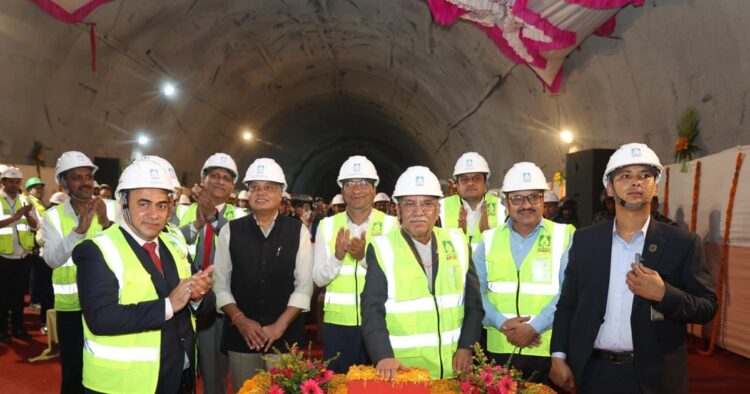Nepal and Bharat have reached a significant milestone in their joint efforts towards clean and sustainable energy with the breakthrough achievement in the Arun III hydropower project.
Prime Minister Pushpa Kamal Dahal of Nepal, alongside Bharatiya Ambassador Naveen Srivastava, commemorated the occasion by initiating the final blast to mark the breakthrough of the 11.8-kilometer headrace tunnel of this pivotal project.
The Arun III hydropower project, situated on the Arun River, is a collaborative effort between Nepal and India, constructed with an investment of approximately USD 1.4 billion. This project, aimed at generating 900 megawatts of electricity, commenced its construction journey back in May 2018 and is categorized as a run-of-the-river type project.
The project, awarded to Satluj Jal Vidyut Nigam (SJVN) through international competitive bidding in 2008, has seen substantial progress over the years. An agreement between the Investment Board Nepal and SJVN in 2014 solidified the partnership for the development of the Arun III project.
During the breakthrough event, Prime Minister Dahal emphasized the project’s significance in fostering closer ties between Nepal and India while contributing to the region’s sustainable development. He lauded the ongoing efforts and reiterated the government’s commitment to ensuring the timely completion of the Arun III project.
Bharatiya Ambassador Naveen Srivastava highlighted the long-term power trade agreement between Prime Minister Narendra Modi and his Nepali counterpart, signaling the import of electricity from Nepal. The completion of the Arun III project is poised to be a pivotal moment in fulfilling this agreement.
Currently, approximately 75 percent of the project work has been completed, with the remaining tasks progressing swiftly. In addition, efforts on the 217-kilometer associated transmission line are underway, indicating comprehensive advancement towards the project’s completion.
The Arun III hydropower project is anticipated to commence electricity generation next year, with a potential output of 3,924 million units annually. SJVN, responsible for executing 2,200 megawatts of hydroelectric projects in the Arun River basin, including the Lower Arun Hydropower Project, signifies a significant step towards meeting energy demands sustainably.
The Lower Arun project, devoid of a reservoir or dam, will complement the Arun III project’s operations. Signed in July 2021, the project is a testament to Nepal’s commitment to harnessing its hydroelectric potential for mutual benefits.
Despite initial delays, the Arun III project stands as a testament to perseverance and collaboration between Nepal and Bharat. With its substantial economic benefits and potential to transform the region’s energy landscape, the project signifies a crucial step towards a greener, more sustainable future for both nations.

















Comments